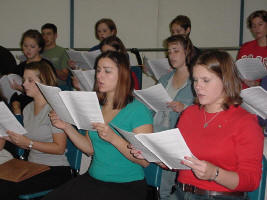|
What is Your Teaching Style? by For more information about Dr. King, visit his faculty web site. Or you may contact him via email. |
Sing in tune! Count the music!
Support the tone! How many times have you heard these types of
statements from former choir directors or colleagues? Better yet, how
many times have you used statements you learned by experience rather than by
understanding the concepts? One of the major problems in the classroom
today is that teachers do not take the time to teach basic concepts, which
seem so obvious, but to a student-musician may appear obscure. We use
many terms that are never explained to the student-musician. Chances
are we learned them in this manner and we may not a clear definition when a
student asks us, "What do you mean, count?" In the classroom, time is
so important. Because of this, we as teachers feel the pressure of an
impending performance and, as a result,
 we
tend to gloss-over some of the basics that we assume our students
understand.
we
tend to gloss-over some of the basics that we assume our students
understand.
There are two approaches or extremes when teaching music imagery or technique. The one that seems the most fun is the imagery approach. Yet this style does not reward the young singer with an understanding of musical concepts. The imagery approach can reinforce concepts once concepts have been learned, but it cannot produce cognitive learning. Let's take an example.
Imagery Approach: "Students this phrase is accented! Pound the notes. Hit them like you would hit a nail!" After singing the phrase through for the second time, you might say, "I still need more attack on each note!" A myriad of other illusions might be employed. In the heat of battle, we have all tossed these illusions to our singers. The singers may execute the phrase as the director wishes, but the students may not really realize what they have done to achieve the desired musical effect or articulation
In the next few months, we will take a closer look at some very common rehearsal phrases like Sing in tune! Count the music! Support the tone! In the meantime, slow down and enjoy the rewards of training total MUSICIANS, not just young performers!
| If you would like to be added to the TSMP Email Mailing List and receive periodic notifications of new articles and updates to this website, then please email TSMP.
The Texas School Music
Project is a source for ideas and information
concerning pedagogical
practices in the music classroom or rehearsal hall. The TSMP is a service provided to
all music specialists by the faculty
of
the Department of Music
at Stephen F. Austin State University. Copyright © 2002, Department of Music at Stephen F. Austin State University |
